Kuala Lumpur, capital of the Southeast Asian country of Malaysia, has always been a “pass-through” destination for me. Either I never made it out of the airport during long layovers, or my time was limited to an overnight stay. I’d made the obligatory trek to see famous twin Petronas Towers, once the tallest skyscrapers in the world, and walk around the lovely lake and park at the foot of the towers. I’d had dinner in the Brickyards neighborhood more commonly known as Little India. And I’d spent one evening exploring Petaling Street, with its gorgeous canopy of scarlet and gold paper lanterns lighting the way past Chinese shops and street food stalls. But other than those three famous things to do in Kuala Lumpur, I never thought there was much to see or do in the city that is commonly referred to as “KL.”

This time, with three days at my disposal, I was determined to discover things to do in Kuala Lumpur other than the top tourist attractions. I began at Masjid Jamek Sultan Abdul Mosque, the oldest mosque in the city. It stands at the confluence of the Gombak and Klang Rivers, on the spot where the city was founded in 1857. The original settlement was borne out of necessity and practicality. The royal family had sent prospectors up the Klang Valley to mine tin. The miners needed to bring in supplies and ship raw ore out to the Strait of Malacca. The point where the two rivers met was the farthest upstream that boats could navigate. A small collection of rudimentary wooden shacks sprang up on the muddy, flood-prone, mosquito-infested spit of land. The settlers named it Kuala Lumpur, which literally means “muddy estuary” in the Malay language.
The original wooden warehouses that once held goods offloaded by barges pulled upriver from the Malacca Strait are long gone. Today the mosque is surrounded by an eclectic mix of traditional pastel painted shophouses and gleaming steel and glass skyscrapers. But it hasn’t always been that way. Years of rapid, unplanned development had penned the rivers between concrete banks, which intensified flooding during the rainy seasons. Rather than look upon the rivers as an asset, developers turned their backs on it. It became a heavily polluted dumping ground that was an eyesore in the center of the most historic quarter of the city.
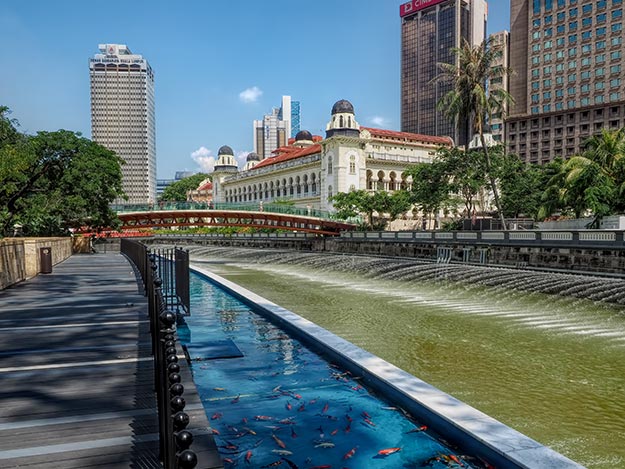
In 2002, the city decided to clean up its mess. They launched the River of Life project, with the goal of cleaning up the rivers and transforming the area into a prime urban destination. The first phase has focused on the “Blue Pool,” an area surrounding the mosque that now features a dancing symphony fountain, blue corridor, fog, and lightning effects. I’m told that the best experience requires a visit after dark, but even by day it was impressive. A couple of times per hour, thousands of spigots along the boardwalk spray jets of water into the rivers, which produces a blanket of mist. As the cloud of mist rises, the mosque seems to float in the air.
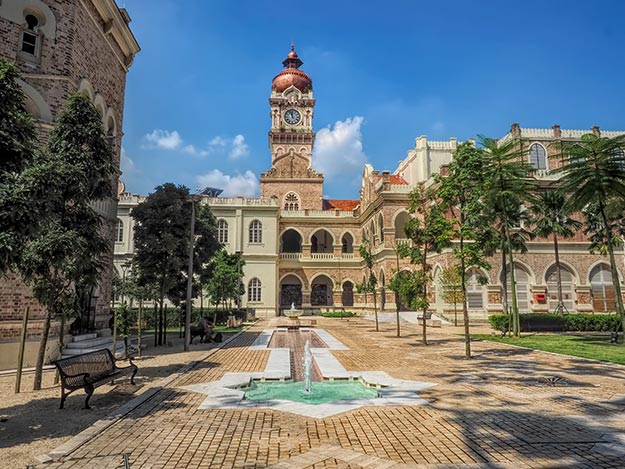
There was plenty to see even when the jets were not operating. The new riverside promenade has been dubbed the Colonial Walk, because it leads past some of the most significant structures constructed during British rule. I strolled past the Old Post Office, the Straits Trading Building, and the Sultan Abdul Saman Building, which was originally a government complex and still serves as a courthouse. I crossed the footbridge over the Gombak River and landed in front of the Old High Court. The two-story building boasts distinctive cupola-topped, buttressed towers at all four corners – an architectural style that was quite rare for its time. Even more puzzling, its arcaded facade features uncommon horseshoe-shaped arches on the second floor, while the arches on the ground floor are all traditional Mughal style.
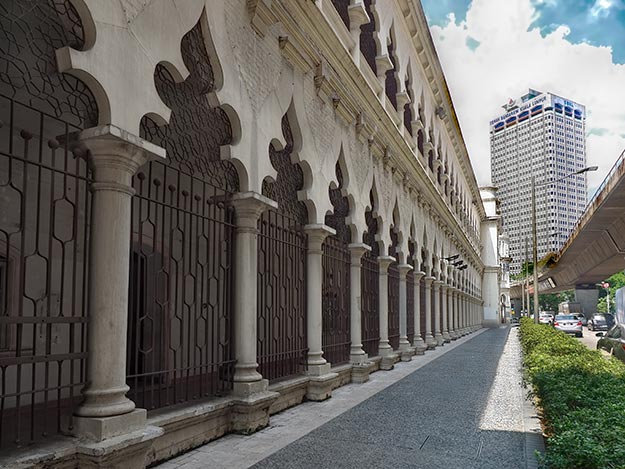
Behind the court is the Old FSM (Federated States of Malay) Survey Office, with its stately five-leaf clover arches. At the end of that long row I rounded the corner and came face-to-face with the Panggung Bandaraya City Theatre, which occupies a 1901 Mughal-inspired building.
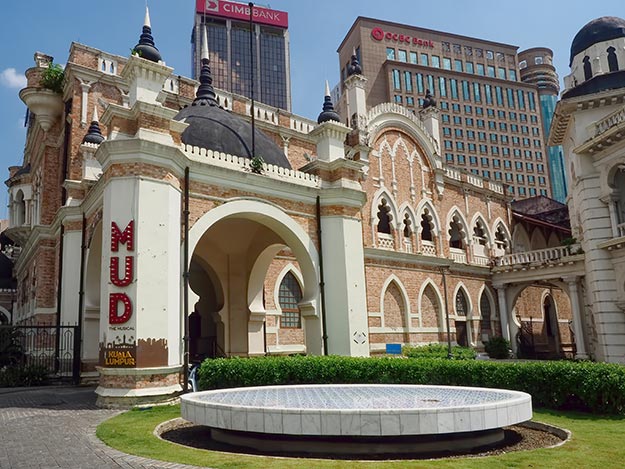
Retracing my steps over the river, I headed for the Kuala Lumpur City Gallery, which is highly rated by tourists. First-time visitors will find this an excellent place to start, as the gallery tells the story of Kuala Lumpur’s past, present, and future through displays that include a massive 40 x 50 foot scale model of the city and its astonishing skyscrapers. Outside, the iconic scarlet “I ‘Heart’ KL” sculpture is equally popular, with visitors snapping photos in and on it, each trying to come up with the most creative pose.

I ended my self-guided tour at Merdeka Square, located adjacent to the City Gallery. Malaysian independence was declared on this spot when the British Union Jack was lowered and the Malaysian flag was hoisted at the stroke of midnight on August 31, 1957. The flagpole, said to be the tallest in the world at more than 311 feet, soars at one end of the huge grassy field that was once the Royal Selangor Club cricket field.
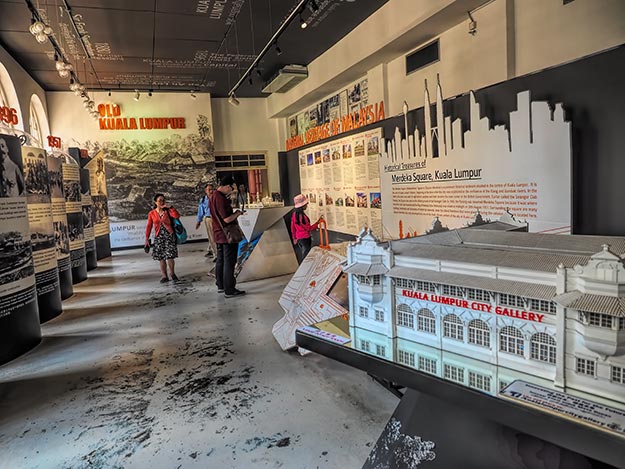
The restoration of this historic district has been especially well-received. Not only is the Colonial Walk now considered to be one of the top ten tourist attractions of Kuala Lumpur, new restaurants, cafes, coffee shops, and entertainment venues are sprouting up all over the neighborhood. It is rapidly becoming the place to be and be seen in the evening hours. Perhaps best of all, the River of Life Project is making a strong case that there’s much more to see in Kuala Lumpur than the Petronas Towers, and much more to do than shop. My recent discoveries have given me a new appreciation for the Malaysian capital, leading me to research even more unknown things to do the city. Recently I was surprised to read about the abundance of hiking trails found in and around Kuala Lumpur. I suspect my discovery tour is nowhere near over!

Hi Barbara: As always I love your travel articles. I fondly remember KL from ’69. I was a stewardess for a chartered airlines, TIA, during Vietnam and was very friendly with a gay fellow from Singapore who had been the first Malay hired by BOAC as a steward many years previously. I visited he and his family that lived in a mansion in Singapore and he told me to visit KL which I did for about 3 days. I took a train with a most luxurious interior with oversized velvet chairs. Back then KL was a backwater city with a huge population that lived on the streets. I’ve been most surprised to hear over the years how KL has changed. Keep up the great traveling and reports. All best,
Audrey
Thank you so much for your lovely comment Audrey. You just made my day 🙂
Good info and great photos, Barbara! I may spend a few days in KL on my way back to Chiang Mai, probably late February. Hope to see you again and compare notes on Malaysia. Take care, life is good!
Hi David: Hope your travels are going well and I’ll look forward to getting together in February.
Thanks for your post about one of my favorite cities , KL. I used to work with Malaysia Airlines in Los Angeles for 8 years and I have so many wicked beautiful memories of KL.i haven’t been there since 2006, it looks like it has changed so much . Thank you again for sharing this and reminding me so much why I lived visiting Malaysia .
You’re very welcome, Jo Ann. Thank YOU for taking the time to leave such a kind comment.
Hi Barbara, Kuala-Lumpur is really a wonderful place to visit. Can you suggest places to see for half day tour ?
Hi Agness: Gosh, if you only have half a day, you probably should go to Petronas Towers and go to the top for the spectacular view. Then you could take the rapid transit to Brickfields (Little India), walk around, and have lunch. The entire neighborhood has recently been renovated and it’s quite attractive.
Thanks for taking me around KL on your walking tour. I plan to be there for several days in February in late February and I’m sure post will be a great help to me.
Hi Betty! You’re very welcome. You’ll probably enjoy it even more than I did because it will be a bit cooler now.